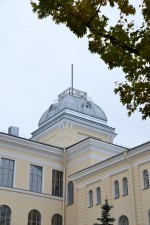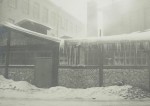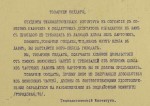In 1914, the First World War began. Although millions of soldiers fought on the front, the conflict was resolved not on the battlefield but in the economic sphere. None of the participating countries had been prepared for an all-out war, but by 1915 most had managed to mobilize their economies for wartime. Catastrophically for Russia, it could not keep up with the industrial demands of wartime, and by 1917 the country's economy was completely inoperable. The transport system could not effectively ship bulky military cargo or secure regular food deliveries to cities. These problems were aggravated by the general incompetence of Nicholas II. The government's apparent inability to wage war strengthened sentiment against the Tsar, leading to the February Revolution. However, the liberal Provisional Government that subsequently came to power turned out to be even less competent. By 1917, the Russian economy had begun to deteriorate, making war impossible. After a flurry of protests, the Bolsheviks, led by V.I. Lenin, came to power. In March 1918, Russia withdrew from the war by concluding a separate peace treaty. However, the tortured country did not get a respite. Following Russia's departure from the global military conflict, the country slid into civil war. The situation was exacerbated by the numerous ill-conceived economic initiatives undertaken by the Bolsheviks. The ailing economy could not bear the strain and collapsed. The year 1920 was one of the most challenging in Russia's thousand-year history.
Russia entered the First World War on July 19, 1914. The subjects of the Russian Empire received this news with enthusiasm. Political differences were abandoned. All political factions, apart from the Bolsheviks, decided to unite for the sake of victory over the foreign enemy. There was also a consensus among the teachers and students at the Institute of Technology: no effort should be spared to defeat Germany and her vassals. Thousands of subjects of the Russian Empire, including hundreds of Petersburgers, were mobilized into the active army. Many volunteered to join the front. Some students at Technolozhka who were released from conscription decided to join the army regardless. At the same time, Russian students studying abroad were forced to return to their homeland after the outbreak of hostilities and were actively searching for opportunities to finish their education. Some of them opted to continue their studies at the Institute of Technology.

Patriotically minded women joined the ranks of nurses. They raised money and other donations for wounded soldiers. The Women's Medical Institute organized a field infirmary of 50 beds named after higher educational institutions in Saint Petersburg and deployed it to the front. The funds for it were raised at all Petrograd universities, including PIT. Professor N.A. Gezekhus presided over the Commission for Infirmary Assistance. On September 16, students at the Petrograd Institute of Technology decided to organize an infirmary within the walls of their university. It was installed in the building of the Mechanical Engineering Laboratory. It was equipped and operated by students and members of the educational and service staff of the Institute.
The infirmary was solemnly consecrated on September 28. It received the first wounded on October 2. The Obukhov Hospital provided the infirmary with medical staff, including three doctors, six full-time nurses, four non-staff nurses, and one non-staff dentist. The hospital also transferred some wounded to the infirmary. A technology student operated the X-ray room. In total, 1020 wounded passed through the infirmary from 1914 to 1917.
After a while, the Institute allocated space for a second infirmary on behalf of the city administration in the drawing rooms located on the third floor of the main building. This infirmary was maintained at the expense of the city administration. In the Chemical Laboratory, students manufactured medical and disinfection applications for the needs of the infirmary. Undergraduates developed methods for the synthetic production of organic medicinal substances such as salvarsan, phenacetin, veronal, and salicylic acid. Algae harvested in the White Sea were delivered to PIT from the Solovetsky Monastery to determine the amount of iodine in them and study methods for obtaining it.
Many Technolozhka laboratories were re-equipped to meet the demands of wartime production. For example, space was allocated for a laboratory testing the possibility of using alcohol as fuel in automobile engines. In one of the laboratories of the Institute, the contents of fuse equipment were produced and shells were manufactured in mechanical workshops. After nearly two years, the workshops developed into a single, full-fledged factory employing close to 1200 students and craftsmen as well as about 50 administration staff. Students organized a shop to repair army motorcycles. Cars were repaired in the PIT courtyard using garage space renovated specifically for this purpose. Spare parts were often manufactured on the spot in the blacksmith and foundry workshops. In total, about 400 motorcycles and cars were repaired in Technolozhka.
The outbreak of the First World War saw many graduates of Technolozhka who switched to work oriented toward the military needs of Russia. Some, like V.I. Yarkovsky, worked at aircraft factories, including the famous Russian-Baltic Aeronautical Plant. Others, like Yu.M. Lebedev, played a role in supplying the army with ammunition and other equipment.
The advent of military aviation in the 1910s led to the need to create anti-aircraft artillery. In Russia, the author of the idea of creating an anti-aircraft gun was a teacher at the Officer Artillery School, Staff Captain V.V. Tarnovsky. Having been approved by the Main Artillery Department in 1914, his preliminary design was sent to the Putilov Plant and assigned to the outstanding engineer F.F. Lender, who had also graduated from SPPIT (1909).
At the students’ initiative, a workshop for servicing army motorcycles was organized. Cars were repaired in the newly renovated garage in the courtyard of the Institute. Spare vehicle parts were frequently made on the spot in the blacksmith’s shop and the foundry. In total, about 400 motorcycles and cars were repaired in Technolozhka. PIT also developed educational programs for short-term courses to train specialists urgently needed in wartime. These included military drivers, hydraulic technicians, chemical instructors in gas technology for the Military Technical Assistance Committee, military construction specialists, junior technicians, and senior foremen for the Military Construction Department, instructors in the heat treatment of steel, machinists for the Society of Breeders and Manufacturers, railway foremen, and specialists in refrigeration. The School Workshop for Lead Soldering began to operate. The Petrograd Institute of Technology opened its premises to hold these classes. The courses for training military drivers started on January 1, 1916, and they were designed to last six weeks. They enrolled second-year students as well as those who were already familiar with car work. The Institute of Technology provided the necessary facilities, including a garage space, and delegated teaching staff to teach two groups of 100 trainees simultaneously. In the School Workshop for Lead Soldering professor G.F. Depp taught autogenous welding and metallization by the method of M. Shoop. A group of 30 students were enrolled. They studied in two shifts for one and a half months. All students were granted draft deferrals. These specialists were required for soldering lead chambers at a sulfuric acid defense plant in the Urals and the Tentelevsky Chemical Plant. A total of 40 masters graduated from this school.
Many graduates of the Petrograd Institute of Technology worked in the defense of the country at various enterprises. For instance, a specialist in high-frequency technology, V.P. Vologdin, served as technical director of the Duflon, Konstantinovich and Co. plant. It produced high-frequency machines for radio stations, generators for airplanes, and various other equipment, such as a record-breaking light generator for the Ilya Muromets aircraft. Specialist in metal heat treatment N.I. Belyaev supervised the construction of the strategic Elektrostal plant.
The Ministry of Public Education issued new guidelines for conducting tests for the title of engineer-technologist on August 12, 1915. The old grading system was phased out in favor of a verbal review with “very satisfactory”, “satisfactory”, and “unsatisfactory” grades. Professors were given permission to organize seminars, but tests were not scheduled throughout the year. As a result, the PIT educational committee voted to give professors the freedom to arrange tests at their discretion during the academic year. The Ministry of Public Education accepted this resolution.
Defeats on the front prolonged the conflict and exacerbated the situation in Petrograd. Due to increased living costs, the necessity for financial help for students became evident in early October 1916. The number of students at Technolozhka had dropped from 2000 to 800 at the start of the 1916/17 academic year. Undergraduates were transferred to military institutions to train as junior officers for the active army, while graduate students were permitted to finish their degrees.
The First World War highlighted the inefficiency of Nicholas II’s government. The incompetence of the authorities led to an explosion of popular discontent in the form of the February Revolution of 1917. The Petrograd Institute of Technology played a critical role in the victory of the Revolution. The PIT building sat at the crossroads of several strategically important roads. Consequently, on March 1, the insurgent soldiers of the Oranienbaum 2nd Machine Gun Training Regiment were quartered on the premises. Machine guns mounted on sandbags could be seen in the windows facing the intersection.
The students formed a police force to patrol the campus and planned food delivery by cars from the Institute's garage. In reality, the Institute became the Revolution's epicenter in this part of Petrograd. The main building held the offices of Professor A.A. Voronov, the commandant of the Moscow unit, and the district commissioner for economic affairs. It was also where all the detained “enemies of the revolution” were imprisoned.
Emperor Nicholas II abdicated the throne on March 2, 1917, at the request of the belligerent soldiers and residents of Petrograd. The Revolution triumphed, and PIT students played an important role in that victory. The collapse of the monarchy resulted in another alteration to the university's name—the name of Emperor Nicholas I, a figure reviled in revolutionary circles, was erased. According to the university's new charter adopted in August 1917, the director of the Institute became rector, and the departments were renamed faculties.
During the revolutionary days, the Soviet of Workers' and Soldiers' Deputies emerged in Petrograd as the “instrument of revolutionary democracy”. A deputy from Technolozhka was also elected to the Council. The elections were held in public, in front of a large audience. M.I. Broydo, a senior Menshevik and 5th-year chemistry student, was almost unanimously elected.
Teaching resumed in May 1917 after being interrupted by the Revolution. Classes lasted until June 20 due to an unanticipated break. In the summer, students who completed their courses and projects were allowed to graduate from Technolozhka, but junior courses could not be completed on time. Overall, the situation in Petrograd remained volatile. Notably, PIT was unable to form an academic council in 1917. In the summer of 1917, there were two other examples of aggressive political activity among the students at the Institute of Technology. The first was a reaction to the “July Days”, which was the Bolsheviks' unsuccessful effort to initiate a revolution. Most PIT students favored fighting the First World War to victory. The slogans “defending freedom, fighting to victory, not giving up an inch of our territory” could all be heard at meetings and rallies. Opponents of the war were branded as “enemies of freedom and the motherland”. An incident was reported in which a Polytechnic Institute student dining at the Institute of Technology's canteen was pummeled by enraged technology students for pulling down a pamphlet accusing the Bolsheviks of collusion with Germany.
The latter outburst of political unrest was associated with the “Kornilov affair”. At a student meeting in the Large Physics Auditorium, a member of the Petrograd Soviet V.N. Filippovsky advocated support for the Provisional Government. However, most students supported General L.G. Kornilov, who called for the restoration of discipline in the army at any cost. His arrest was met with apathy, however, and subsequent events elicited little outrage.
On August 3, 1917, a memo was published in the Bulletin of the Provisional Government announcing that institutions of higher education that had set forth examinations were granted the right to substitute them with a competition of certificates. It also stated that the start of classes in higher educational institutions was postponed until October 2.
The Provisional Government was overthrown in Petrograd on October 26, 1917. The Bolsheviks, led by Vladimir I. Lenin, took power. The events of October disrupted classes at the Institute, which had begun earlier that month. Despite the fact that academic activity at the Institute came to a halt, students' and professors' social lives continued. N.P. Gorbunov, a chemist who had recently graduated from the PIT, was among those who backed the new regime. He was appointed secretary of the Soviet government's Council of People's Commissars. S.G. Lazo, a former PIT student who tragically fell victim to Japanese occupiers, played a crucial role in the foundation of Communist rule in the Far East. During a PIT meeting on December 19, 1918, a trade union was formed. Envoys from the Institute began attending meetings of the Union of Workers of Cultural and Educational Institutions in Petrograd and its environs in 1919.
Despite the onset of the Civil War and the dire situation in the country, a steady revival of science began around 1918. The new administration urged the finest scientists to establish new research centers as the foundation for the country's economic and industrial development. In 1918, the Scientific and Technical Department (STD) was established at the Supreme Council of the National Economy. It was headed by N.P. Gorbunov, who had graduated from PIT in 1917. The STD was tasked with creating large new research centers in Russia.
During the first years of Soviet rule in Russia, research institutes began to emerge, notably in Petrograd. Graduates of the Institute of Technology were instrumental in the foundation and development of these centers. For instance, A.F. Ioffe, who graduated from the Institute in 1902, created the State Radiographic and Radiological Institute in 1918. Radium and Physico-Technical Institutes were founded on its basis in 1922. The latter became the cradle of Russian nuclear physics.
L.A. Chugaev, who was a professor at the Institute of Technology, initiated the establishment of the Institute for the Study of Platinum and Other Precious Metals. In 1918, a radio laboratory was built in Nizhny Novgorod. One of its founders was V.P. Vologdin, who had graduated from the SPPIT in 1907. Around that time, the Optical Institute and the Central Chemical Laboratory were founded in Petrograd. Nowadays, it is called the Physico-Chemical Institute. In 1919, the Russian (later State) Institute of Applied Chemistry was established in Petrograd. Its scientific council included professors A.E. Favorsky, A.E. Poray-Koshits, A.A. Yakovkin, S.P. Vukolov, P.P. Fedotyev, and L.A. Chugaev. In essence, the Soviet Union built the scientific underpinnings for a highly autonomous chemical industry, allowing the country to reduce its reliance on foreign technology. It became clear that the new government prioritized the development of domestic industry and encouraged the application of the latest achievements in science and technology to industrial production.
The Institute of Technology, like any other higher educational institution at the turn of the 20th century, was a hub of science and education as well as political campaigning. It is thought that the Constitutional Democratic Party's liberal principles were popular among lecturers, while students gravitated toward revolutionary socialism. During the First World War, many professors and students at the Institute took a patriotic stance. The vast majority of them supported the February Revolution of 1917, seeing it as an opportunity to secure victory in the war with Germany. Most technologists were highly opposed to the Bolshevik-led October Coup, which favored Russia's surrender to Germany. Subsequent events divided students and teachers into those who remained in Soviet Russia and those who ended up in exile. Some left the country willingly; others found themselves abroad by circumstance. Some teachers, mostly representatives of the older generation, did not get through the era of economic “ruin”. The Institute of Technology, as an active participant in the events that rocked the country, shared the fate of post-revolutionary Russia.
At the turn of the 19th and 20th centuries, Saint Petersburg was the most important center of culture for Estonians and Latvians. More Latvians lived in Saint Petersburg than in Riga. Likewise, more Estonians lived in Saint-Petersburg than in Revel (modern Tallinn). The Baltic provinces had the highest literacy rate in Russia. The reason for this was that serfdom was abolished there half a century earlier than in mainland Russia. A significant number of immigrants from Estonia, Livonia, and Courland attended universities in Saint Petersburg, including the Institute of Technology. The same applied to Lithuanians. At the beginning of the 20th century, Lithuania was not part of the Baltic States. Instead, it formed a single cultural space with Poland. As Catholics, Lithuanians were subject to the same restrictions as Poles. It was difficult for them to enroll in universities in the Privislinsky and North-Western territories. Still, there were no fewer Lithuanians at the Institute of Technology than Estonians or Latvians. After Estonia, Latvia, and Lithuania gained independence as a result of the collapse of the Russian Empire, many graduates of Technolozhka took prominent positions in the political and economic lives of the new states.




















